Guess why this South American bird is called a Bearded Bellbird.
(video from YouTube)
p.s. that beard is not made of feathers. It is long stringy skin. 😮
Guess why this South American bird is called a Bearded Bellbird.
(video from YouTube)
p.s. that beard is not made of feathers. It is long stringy skin. 😮
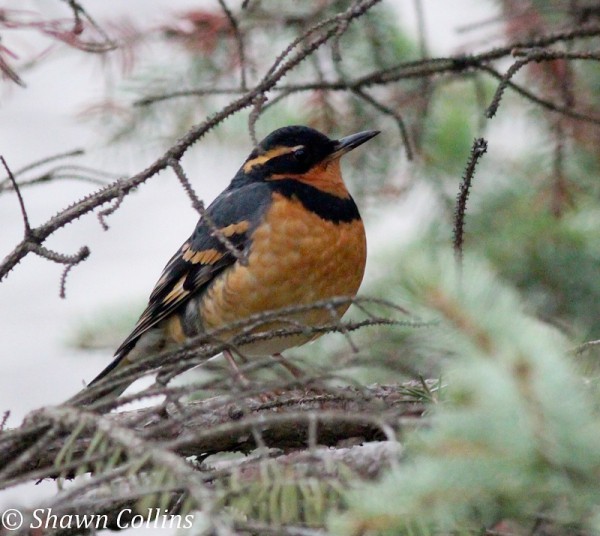
Though he looks like a fancy robin this is actually a varied thrush, a bird that breeds from Alaska to Northern California.
Most varied thrushes spend the winter south of their breeding grounds but a few individuals fly east and end up as far away as Maine and Newfoundland.
This one caused a sensation when he was found in Avon Lake, Ohio in early December.
Thanks to Shawn Collins for making the trip on December 9 and posting his photographs for all to enjoy.
(photo by Shawn Collins)
Yesterday I wrote about copepods and polynyas so I could introduce this bird, the dovekie.
Though I visit Maine every September and even take pelagic trips in the Gulf of Maine, I have never seen a dovekie. That’s because they breed on islands in the High Arctic (Baffin Island, Greenland, Iceland, etc) and don’t leave their breeding grounds until late August. At that point they’re molting and flightless so they drift on the southbound current to spend the winter in the North Atlantic. They usually aren’t seen off the coast of Maine until November.
Dovekies (Alle alle), also called little auks, are cute little seabirds about the size of a starling but much fatter — two to three times the weight of a starling. They are so numerous that there are tens of millions of them in the North Atlantic in winter.
The two shown above are in breeding plumage at Svalbard. Their eyes are black but look white in this photo because they’re half closed. Perhaps they’re whispering sweet nothings to each other.
In the U.S. we only see dovekies in winter plumage. Here’s a video of one off the coast of North Carolina in January that gives you a sense of how tiny these birds are.
In the breeding season dovekies depend on cold water and ice. Copepods are their favorite food — sometimes their only food — so they locate their breeding colonies near polynyas where copepods are plentiful. In a curious way they’re an edge species, preferring the fertile edge where ice meets open water.
Dovekies are so numerous that you’d think that nothing could threaten their survival. Unfortunately they are easy to hunt at their breeding colonies and global climate change may lower their breeding success.
But who knows? Maybe The Big Melt will help dovekies for a while.
(photo by Michael Haferkamp on Wikimedia Commons. Click on the image to see the original)
Here’s an Asian pheasant, a Temminck’s tragopan, that normally looks vermillion, black, white and brown.
When he’s in an amorous mood he shakes his head to begin his courtship display. Two long blue horns pop up from his head and the small blue patch under his chin drops down to reveal an intricate iridescent blue lappet.
He opens his wings, puffs his body, and continues to shake his head to perfect his display.
And just in case his lady doesn’t notice, he clacks his beak.
Look at me!
Click here to see another Temminck’s tragopan with an even bigger, better lappet. In a contest between the two, I bet the ladies will pick the guy with the bigger bib.
(video from YouTube)
p.s. The name “tragopan” has an interesting origin: Trago is the Greek work for goat, Pan is the Greek god of the wild whose shape is half man, half goat.
Ice has been in the news lately from its stunning disappearance in the Arctic Ocean this summer to it’s dramatic melting around the world chronicled in the new documentary Chasing Ice.
What will we lose when the ice disappears? What birds depend on the Arctic climate?
I don’t know if this bird will suffer but I can tell you it depends on the tundra and tundra depends on ice.
The long-tailed jaeger (Stercorarius longicaudus) is a holarctic bird who spends the winter over the open ocean in the southern hemisphere, often at the edge of the continental shelf. Because they migrate over the ocean, long-tailed jaegers are exceedingly rare in Pennsylvania having been documented only three times.
Long-tailed jaegers nest in the Arctic where their breeding success depends on an abundance of lemmings and voles. In the High Arctic of North America they depend on a single species: the collared lemming. If there aren’t enough lemmings, long-tailed jaegers don’t even bother to breed.
As the ice melts, the tundra will change and eventually be overtaken by woody plants. Will this reduce the population of lemmings?
If it does, long-tailed jaegers will stop breeding and eventually disappear … with the ice.
(photo by Jerzy Strzelecki on Wikimedia Commons. Click on the image to see the original)
When five rooks came to celebrate my blog’s anniversary last week they piqued my interest because we never see them in North America.
Rooks are Eurasian relatives of crows, found from Ireland to Japan. At a distance they look like American crows with very long beaks but this is an illusion. Their beaks look long because the skin on their faces is naked and matches the beak color.
Close up the skin is obvious and a bit disturbing if you’re not used to it. When they perch with wings hunched and feathers puffed they resemble the Grim Reaper. Actually, artists probably chose rooks as their model for the Grim Reaper and not the other way around.
Like blue jays, rooks can store food in their throat bags, then carry it elsewhere. The throat becomes distended as you can see briefly in the video above.
Rooks are more social than their American relatives. They nest communally in the treetops in collections called rookeries. In North America we have no rooks but our herons use the same nesting technique so we call their groupings heron rookeries.
Like crows, rooks are curious and really smart but this can make them annoying. To a rook, it’s normal to make holes to hide food but this is a liability if you keep one indoors. Fortunately, few people do.
Early this year I enjoyed reading Corvus: A Life With Birds by Esther Woolfson in which she tells the story of her rook named Chicken, a very smart and engaging bird, but I agree with the Daily Mail which said, “Yet perhaps the best measure of Woolfson’s candidacy for sainthood is the permission she has given Chicken to dismantle the plaster and lath on her hallway wall so that the rook has its own food storage space.”
…You see what I mean…?
Smart… but not good pets.
(video by Goldfinch Garden on YouTube)
This feather is 150 million years old, give or take a millenia.
Found in Solnhofen, Germany and documented by Hermann von Meyer in 1861, the Urvogel Feather (“Original Bird” Feather) caused a sensation for several reasons:
Feather fossils are rarely found because they must form in finely grained material in an anoxic environment.
Back in the Jurassic period when the Urvogel feather fell from an Archaopteryx’s wing, Bavaria was a group of tropical islands. The feather landed on water — probably still attached to the dead dinosaur — and eventually settled to the bottom in a “dead zone” where the lack of oxygen prevented it from decomposing.
The sediment became limestone so finely grained that it led to the invention of lithography in 1796. These quarries produce high quality stones for print-making and uncover many fossils.
Eventually 11 fossils were identified as Archaeopteryx, a raven-sized feathered dinosaur shaped like a magpie. In 2011 scanning electron microscopy revealed that some of its feathers were black.
Naturally “Archy” has generated a lot of discussion over the years — from analyses placing him in the trajectory of dinosaurs to birds, to arguments denouncing evolution that said his fossils were fake. (Those arguments were easily debunked because their authors misunderstood geology.)
150 million years since it died, 150 years since it surfaced, the Urvogel Feather has made a lasting impression.
(photo taken at Museum für Naturkunde in Berlin where the Urvogel Feather was on display for its 150th anniversary. Click on the image to see the original on Wikimedia Commons)
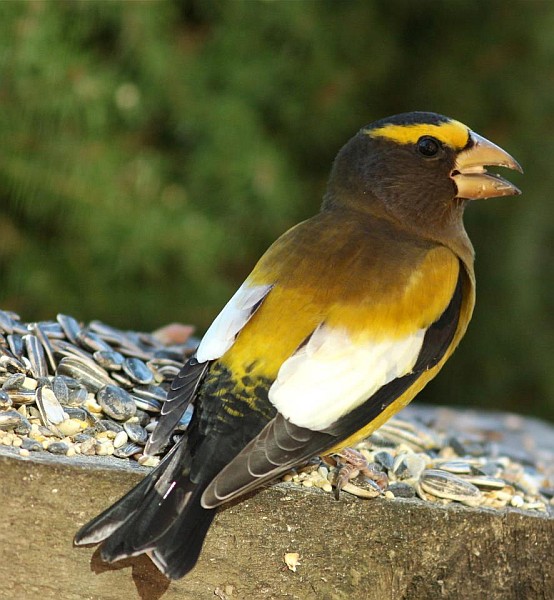
I have never seen an evening grosbeak, but this winter I might get my chance.
For the first time in years, evening grosbeaks are coming south in big numbers because there aren’t enough tree seeds in Canada. Without food at home they’re on the move in a variable migration called an irruption.
Winter irruptions are not uncommon, but evening grosbeaks are. Last winter snowy owls came to western Pennsylvania, pine siskins and white-winged crossbills visited in 2008-2009 and redpolls in 2007-2008. But evening grosbeak sightings have declined over the years.
Happily, on November 5 the grosbeaks arrived at Marcy Cunkelman’s yard in Indiana County (here’s a beautiful male at her feeder), but alas, they were gone by this weekend when I could travel to see them.
So now I wait for news of a reliable *weekend* flock of evening grosbeaks near Pittsburgh.
Will I see my first one this winter? I hope so.
(photo by Marcy Cunkelman)
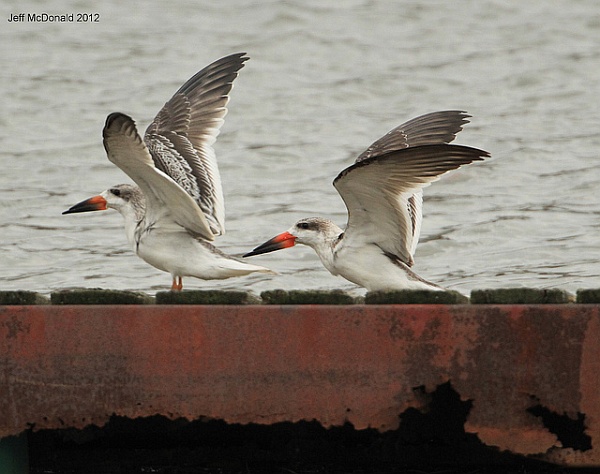
As Hurricane Sandy blew through New York and New Jersey it picked up many sea birds and blew them inland. Some rode the storm’s high winds, others were trapped in the eye of the hurricane and flew all night inside its calm center, waiting for daylight so they could see where to land.
By midday Tuesday, October 30 there were near blizzard conditions and 45 mph winds over Pennsylvania’s southern mountains as the eye of the storm hovered over Bedford County before turning north. At this point many water birds dumped out of the storm onto Shawnee Lake where Mike Lanzone reported at least 10 unusual species including a black-legged kittiwake, American oystercatchers, a leach’s storm-petrel, and pomarine and parasitic jaegers.
Many storm birds flew home immediately but five days later these two juvenile black skimmers showed up in Pittsburgh. As soon as Mark Vass reported them on the Ohio River at McKees Rocks, Pittsburgh area birders flocked to see them including Jeff McDonald who took these pictures.
Black skimmers (Rynchops niger) are quite common on the shores of Long Island and New Jersey at this time of year where they eat small fish from the ocean’s surface. They capture them by skimming the water with their long lower mandibles. You can see this odd beak as a bird casts a pellet below.
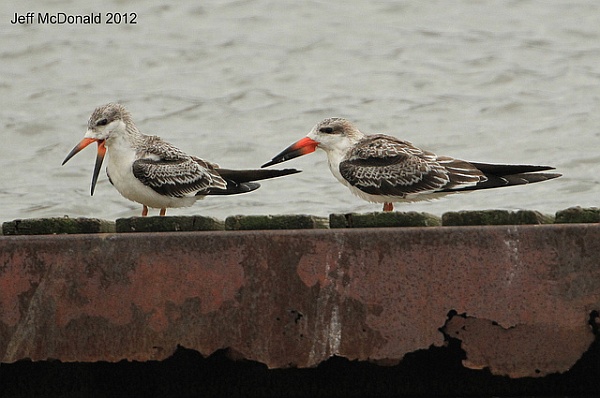
And here you can see one skimming.
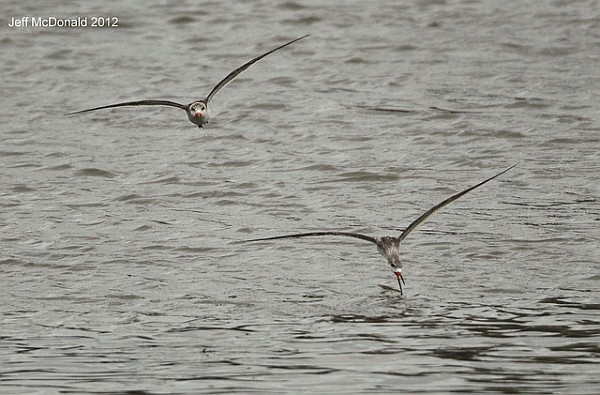
But there might not be enough food for skimmers in the Ohio River in November. In North America skimmers are strictly coastal birds because the sea serves up small fish every day, but in Pittsburgh the river fish drop into deep water in winter, unreachable by skimmers.
Now, a week later, there is only one black skimmer at the marina.
(photos by Jeff McDonald)

Here’s a bird so unusual that it has no living relatives. It is the only species in its genus, family and order. Even with DNA evidence scientists have found nothing quite like it. The best they can say is that Opisthocomus hoazin is … a bird.
The hoatzin (pronounced “watson”) is a noisy, colorful, pheasant-sized bird that lives in the swamps and river forests of the Amazon and Orinoco basins in South America. Like herons it nests communally in trees or shrubs over water. But unlike any other bird the hoatzin eats leaves almost exclusively. Leaves are 82% of its diet.
Leaves are not very nutritious and require bacterial fermentation to digest them. Leaf-eating mammals (cattle, sheep, goats) have a rumen for that purpose. Hoatzins have a huge crop that does the job, but it’s so large and heavy that the birds are clumsy in flight.
Fortunately, they don’t need to fly to escape. The fermentation in their crops is so foul that adult hoatzins smell like manure. Few animals want to eat them.
Hoatzin eggs and young are preyed upon but the young have unique escape tools. Before they grow flight feathers they have claws on the thumb and forefinger of each wing — like dinosaurs! When danger threatens they drop from the nest into the water below, swim away and then climb back to the nest using their finger and toe claws.
Since people rarely hunt them, hoatzins seem tame and are easy to find.
Stinky bird in the Amazon jungle gloom? It’s a hoatzin, I presume.
(photo from Wikimedia Commons. Click on the caption to see the original)